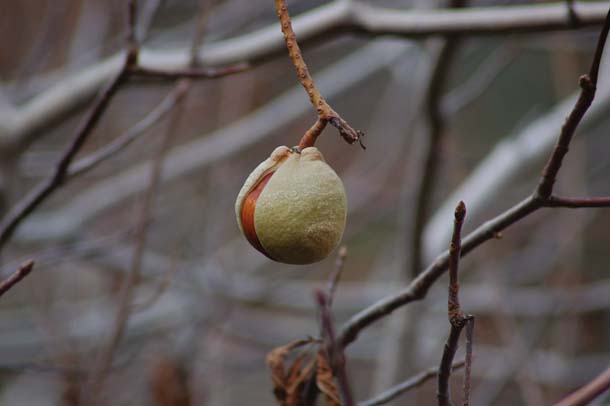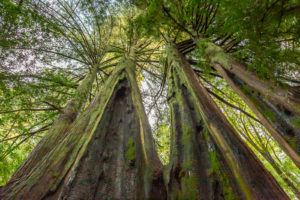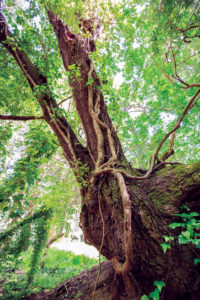My grandfather, like many men of his time and place, carried a buckeye in his pocket, a seed from one of the Ohio buckeye trees that grow in the Ozarks. Shiny mahogany-brown with a tan “eyespot,” it was reputed to ward off rheumatism and bring general good luck. It probably also just felt good in his hand. A much-handled buckeye has the patina of old leather.
My personal buckeye, not to be competitive, is bigger than his: It’s the seed of a California buckeye (Aesculus californica). This California near-endemic (but for one population in Oregon) is a familiar presence in the Coast Ranges and Sierra foothills. As Glenn Keator describes it in Introduction to Trees of the San Francisco Bay Region, it offers a visual feast through the year: “bare, silver gray bark glows in winter light; new, apple green leaves appear in early spring; candles of white to pale pink, fragrant flowers light up forests and woodlands in late spring; and leathery, pear-shaped seedpods decorate the trees in late summer and fall.” Some landscapers use it for its distinctive winter silhouette. But I think fall is the buckeye’s characteristic season, when the leafless crooked branches are hung with pods.
Buckeyes are an ancient lineage. Although taxonomists disagree as to whether the genus Aesculus originated in Asia or North America, fossils document its presence in the American West in the Paleocene, just after the demise of the dinosaurs.
- The buckeye’s nutrient-rich seeds are toxic to many animals. Photo by Ron Sullivan, www.selbornesurveys.com
California buckeye’s ancestors appear to have been accustomed to cooler, wetter climates than our present Mediterranean regime. With the advent of drier summers about three million years ago, many of the buckeye’s forest associates died out, but it survived as a “drought evader,” cutting its evaporative losses by shedding its leaves in summer.
The summer-deciduous option comes at a price. The tree can’t use the nutrient factories in its leaves to grow its fruit. In field studies at Jasper Ridge in the 1970s, Stanford plant ecologist Harold A. Mooney found that buckeyes have high photosynthesis rates in spring; when that process shuts down, the tree draws on carbohydrate reserves in its trunk and roots to supply its seeds with nutrients. Still, fruit production takes a lot out of a buckeye branch; fruiting branches may be late to leaf out the following year.
Rolf Benseler, who formerly taught at Cal State East Bay, calls the tree’s breeding method “highly inefficient.” Most of the 200 or so flowers in each of a buckeye’s large inflorescences are male; only about 10 percent have ovaries. Despite the services of pollinators like the variable checkerspot butterfly, less than 10 percent of that 10 percent produce fruit, each typically with a single seed.
It’s quite a seed, though, the largest of any California native plant’s, averaging close to an ounce in weight and two inches in diameter. It’s packed with nutrients to give the seedling a competitive edge against close neighbors, and its moisture content offers a hedge in dry environments. The seed is loaded with toxins as well: glycosidal compounds called aesculin and aesculetin. The whole tree is toxic, in fact.
That makes seed dispersal an interesting proposition. Oaks and pines depend on seed predators like squirrels and jays to move their progeny away from the parent tree; any seeds not retrieved have a chance of germinating. Buckeyes rely more on gravity: the pod splits and the seed drops, bounces, and rolls. Still, the trees aren’t limited to valley bottoms. Some grow on ridges, hilltops, even cliff edges. How did they get there?
According to Benseler, some mammals are undeterred by the plant’s toxic defenses. California ground squirrels feed on buckeye seeds, and there are reports of seed consumption by wood rats, deer mice, and black-tailed deer. And we can always speculate about dispersal by extinct megafauna like ground sloths.
But California Indians may have been more likely dispersal agents. Many tribes–including the Coast Miwok, who called the tree ah’-te–used buckeye seeds both as a toxin to immobilize fish for easy harvest and as food itself (after leaching out the toxic compounds) and medicine. Those ridgetop trees could be the descendants of trees grown from seeds the Indians discarded at processing sites.
Or maybe the seeds just felt good in their hands.

.jpg)




